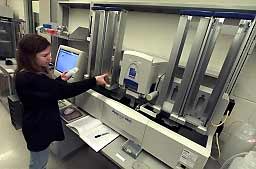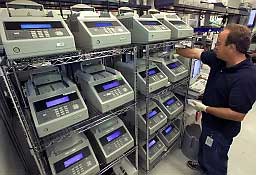
The PlateMate Plus robot transfers colonies from 384-well stock plates to new 384-well plates for lysing.
At this point, our plasmids are still trapped inside the bacterial cell. To get to our original fragment, we need to isolate the plasmid from the rest of the cell. This starts with the PlateMate Plus robot (shown below). The robot takes 2 µl from the 384-well culture stock plate and puts it onto a new 384-well plate. Each well on the new plate also contains 8 µl of Amersham denature buffer.
The 384-well plates containing the denature buffer and bacteria from the culture stock plate are placed in a thermal cycler at 95°C for five minutes. At this point, the cells “lyse,” meaning that their plasma membrane breaks and the cellular contents spill out into solution.

Thermal cyclers heat up bacterial cells to break them open.